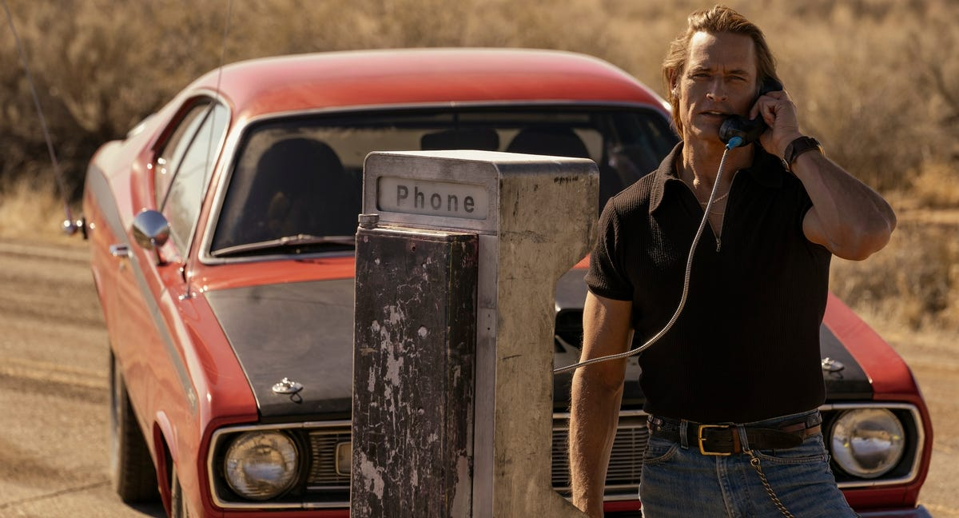On paper, HBO’s new muscle car crime drama Duster has all the makings of a great new TV series. Cool cars, great 70s fashion, fight scenes and a killer soundtrack. The only thing missing so far is a decent script.
Set in Phoenix, Arizona in 1972, the series follows getaway driver Jim Ellis (Josh Holloway) and FBI rookie Nina Hayes (Rachel Hilson) as they set out to take down crime boss Ezra Saxton (Keith David).
The really frustrating thing about Duster is that it gets so close and yet fails at almost every screeching turn. The show never seems entirely sure of itself or what it’s trying to be. Is it a hammy tribute to the muscle car capers of the era or a serious crime drama about characters and their families and tragic pasts?
Is it trying to be the next Smokey and the Bandit – or a lecture on racism in the 1970s Federal Bureau of Investigation? Is Jim Ellis a live-fast, die-young scoundrel or just a mostly pretty nice guy with a heart of gold who just happens to be working for the mob? And would any rookie FBI agent get away with the kind of shenanigans and insubordination Agent Hayes is pulling from day one or is everyone just treating her badly because she’s a black woman?
Is this a show we’re supposed to take seriously (as seriously as it apparently takes itself) or just meant to be escapist fun?
Tonally, Duster is all over the map. When it’s having fun, the series shines. The car chases are great. There’s one dust-up in a bowling alley that’s particularly memorable. A heist at the Palm Springs house of Elvis Presley was another highlight, though they could have done so much more with it. But for each of these great bits of good old-fashioned entertainment, the show manages to bog itself down with awkward preachiness and never quite matches its cool sense of style with particularly creative filmmaking or memorable cinematography.
A big problem from the jump is Nina Hayes, who serves as Duster’s Strong Female Black Woman trope rather than a fully realized character. Hilson is charming and does a solid job here, but she’s badly served by the script.
Hayes arrives at the Phoenix office of the FBI to face immediate, in-your-face racism from the white male agents. She comes in guns blazing and they shoot her right down. None of the actual, far more nefarious and subtle racism of a 1970s FBI office makes it to the screen and we never actually see Nina struggle with it beyond the odd speedbump or two – setbacks she easily overcomes.
Of course, Nina has zero sense of self-preservation – not that she needs any. Apparently the really terrible racism of the 1970s was all just bluster. Nina is just cool enough and just tough enough and just rogue-agent enough that her detractors, no matter how hard they try, can’t make anything stick.
If the show actually knew what it was trying to be, maybe this wouldn’t matter. Have a bozo FBI racist white dude and a super cool black female agent and play it for laughs. Dial everything way up. But as it stands, if the point of all this is to show the audience how hard it was for a black woman in the 1970s FBI, Duster is doing a terrible job. We’re told that racism back then was cartoonishly bad, but actually overcoming it was super easy, barely an inconvenience.
Jim, meanwhile, is all wrong despite a solid performance from Holloway. They needed to double down on the fact that he’s a criminal. Make him more reckless, more devil-may-care, and more a product of his time. As it stands, it’s kind of hard to understand why he’s even in this life. He’s a bad boy without any grit. A lady’s man without the chauvinism. Give him some texture for goodness sake (and maybe a little scruff on that clean-shaven face while you’re at it). Like Hayes, he’s too instantly competent at everything.
Duster could have gone one of two different directions. It could have been a dark, serious crime drama set in the 1970s with important themes about racism and sexism or it could have been a zany muscle car power fantasy using the 70s as a cool backdrop. Settling on a half-baked version of both leaves it in an awkward, tonally messy middle-ground that misses the mark more often than not. As one reader noted, it’s like an Elmore Leonard novel without the snappy dialogue or Tarantino with the edges sanded down. Jackie Brown this is not.
All that being said, after two episodes I’m definitely having fun. I like Jim and Nina despite their shallow characterization, even if they’ve leaned too hard into girlboss tropes for Nina and played Jim way too straight. Keith David is as good as ever as Saxton, and the supporting cast is mostly on-point. I’m okay with the tropey humor and the action is entertaining. Perhaps most importantly, I’m looking forward to the next episode in spite of all my complaints. Maybe Duster will find its feet – or wheels, as the case may be – as the season continues.

